|
|
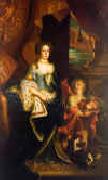 |
Jacob Huysmans
|
|
1633-1696
Flemish
Jacob Huysmans Gallery
Jacob Huysmans (c.1633?C1696), was a Flemish portrait painter. He moved to England during the reign of Charles II where he became one of the fashionable painters of the court. His chief portraits are those of Izaak Walton and Catherine of Braganza, Charles II's wife (both displayed on the National Gallery, London).
He was a pupil of Gilles Backereel and Frans Wouters and came over to England from - presumably - Antwerp. His first works were pastiches of work from Anthony van Dyck. As a Roman Catholic he was favoured by Catharine of Braganza. When Samuel Pepys visited his workshop in Westminster on 26 August 1664, he described him as a 'picture-drawer ... which is said to exceed Lilly (Lely). Huysmans's most important portrait of Catharine of Braganza, Queen Catharine as a Shepherdess (c. 1664; Brit. Royal Col.), was one of the pictures Pepys saw on that occasion. Painting his subjects as sheperdesses with clothing embellished with embroidery and jewellery were typical of his style.
|
|
|
|
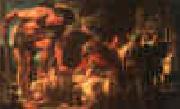 |
Jacob Jordaens
|
|
Flemish Baroque Era Painter, 1593-1678
Jacob Jordeans was born on May 19, 1593, the first of eleven children, to the wealthy linen merchant Jacob Jordaens Sr. and Barbara van Wolschaten in Antwerp. Little is known about Jordaens's early education. It can be assumed that he received the advantages of the education usually provided for children of his social class. This assumption is supported by his clear handwriting, his competence in French and in his knowledge of mythology. Jordaens familiarity with biblical subjects is evident in his many religious paintings, and his personal interaction with the Bible was strengthened by his later conversion from Catholicism to Protestantism. Like Rubens, he studied under Adam van Noort, who was his only teacher. During this time Jordaens lived in Van Noort's house and became very close to the rest of the family. After eight years of training with Van Noort, he enrolled in the Guild of St. Luke as a "waterscilder", or watercolor artist. This medium was often used for preparing tapestry cartoons in the seventeenth century. although examples of his earliest watercolor works are no longer extant. In the same year as his entry into the guild, 1616, he married his teacher's eldest daughter, Anna Catharina van Noort, with whom he had three children. In 1618, Jordaens bought a house in Hoogstraat (the area in Antwerp that he grew up in). He would then later buy the adjoining house to expand his household and workspace in 1639, mimicking Rubens's house built two decades earlier. He lived and worked here until his death in 1678.
Jordaens never made the traditional trip to Italy to study classical and Renaissance art. Despite this, he made many efforts to study prints or works of Italian masters available in northern Europe. For example, Jordaens is known to have studied Titian, Veronese, Caravaggio, and Bassano, either through prints, copies or originals (such as Caravaggio's Madonna of the Rosary). His work, however, betrays local traditions, especially the genre traditions of Pieter Bruegel the Elder, in honestly depicting Flemish life with authenticity and showing common people in the act of celebratory expressions of life. His commissions frequently came from wealthy local Flemish patrons and clergy, although later in his career he worked for courts and governments across Europe. Besides a large output of monumental oil paintings he was a prolific tapestry designer, a career that reflects his early training as a "watercolor" painter.
Jordaens' importance can also be seen by his number of pupils; the Guild of St. Luke records fifteen official pupils from 1621 to 1667, but six others were recorded as pupils in court documents and not the Guild records, so it is probable that he had more students than officially recorded. Among them were his cousin and his son Jacob. Like Rubens and other artists at that time, Jordaens' studio relied on his assistants and pupils in the production of his paintings. Not many of these pupils went on to fame themselves,however a position in Jordaens's studio was highly desirable for young artists from across Europe. |
|
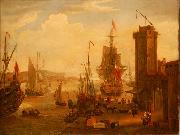 |
Jacob Knyff
|
|
(January 1, 1639, Haarlem - 1681, London), was a Dutch Golden Age painter.
According to Houbraken he was the teacher of Johannes Gottlieb Glauber in Paris in 1671, where he attended the funeral of Nicolaes Berchem II on January 4, 1672. he was probably the son of the painter Wouter Knijff, and is known for painting landscapes and seascapes |
|
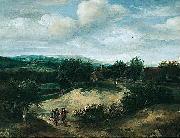 |
Jacob Koninck
|
|
(c. 1615, Amsterdam - c. 1695, Copenhagen), was a Dutch Golden Age landscape painter.
According to Houbraken he lent his books on perspective to Johannes Verkolje, who became better than he was at perspective drawing.He was a disciple of Adriaen van de Velde who became a popular painter in Copenhagen where he painted for the court of Christian V of Denmark.
According to the RKD he was the uncle of Salomon Koninck, a pupil of David Colijns and became the teacher of his son Jacob II and his younger brother Philips Koninck.He was in Dordrecht from 1633-1636, Rotterdam from 1637-1645, The Hague from 1647-1651, back in Amsterdam in 1658 (when he probably lent young Verkolje his perspective books), and moved to Denmark in 1676.
|
|
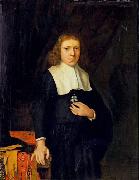 |
Jacob Levecq
|
|
(1634 - 1675), was a Dutch Golden Age painter trained by Rembrandt.
According to Houbraken, who was his pupil during the last 9 months of his life, he had been trained by Rembrandt, but inherited a sum of money when his parents died, that he used to take care of himself, his two unmarried sisters and a blind half-brother. Houbraken could not recall much of his painting style, since he had been mostly sick while he was living in the house, and he no longer painted actively. In his younger years Levecq travelled to Paris and Sedan where he painted portraits, and on his return to Dordrecht became a portrait painter in the manner of Jan de Baen. When he died, Houbraken inherited a third of his prints, but regretted the fact that as a young boy with little experience in such matters, he only chose prints by Lucas van Leyden and Albert Durer, and had left the French prints for others, and so was very glad that he had received one anyway by Charles le Brun. |
|
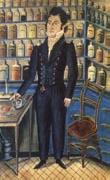 |
Jacob Maentel
|
|
American physician and watercolor portraits painter,1763-1863 |
|
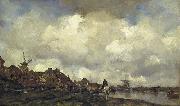 |
Jacob Maris
|
|
(August 25, 1837, The Hague - August 7, 1899, Karlsbad) was a Dutch painter, who with his brothers Willem and Matthijs belonged to what has come to be known as the Hague School of painters.
Maris studied at the Antwerp Academy, and subsequently in Hubertus van Hove's studio during a stay in Paris from 1865 till 1871. He returned to Holland when the Franco-Prussian War broke out, and died there in August 1899. Though he painted, especially in early life, domestic scenes and interiors invested with deeply sympathetic feeling, it is as a landscape painter that Maris excelled. He was the painter of bridges and windmills, of old quays, massive towers, and level banks; even more was he the painter of water, and misty skies, and chasing clouds. In all his works, whether in water or oil color, and in his etchings, the subject is always subordinate to the effect. His art is suggestive rather than decorative, and his force does not seem to depend on any preconceived method, such as a synthetical treatment of form or gradations of tone. And yet, though his means appear so simple, the artist's mind seems to communicate with the spectator's by directness of pictorial instinct, and we have only to observe the admirable balance of composition and truthful perspective to understand the sure knowledge of his business that underlies such purely impressionist handling.
|
|
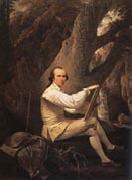 |
Jacob More
|
|
1740-93
Scottish painter, active in Italy. The son of an Edinburgh merchant, he was first apprenticed to a goldsmith and then, from 1766, to the Norie family of house-painters. In the 1760s he produced numerous sketches of the Scottish Lowlands (examples Edinburgh, N.G.), and in 1769 he designed and executed stage sets at the Theatre Royal, Edinburgh, for the first productions after the legalizing of the theatre in Scotland. More's Edinburgh period culminated in a series of oil paintings of the Falls of the River Clyde, three of which are in public collections: Corra Linn (Edinburgh, N.G.), Stonebyres Linn (London, Tate) and Bonnington Linn (Cambridge, Fitzwilliam). These paintings are regarded as the first serious artistic interpretations of the Scottish landscape, depictions by previous artists having been essentially topographical in character. More took a set of three of them to the Society of Artists Exhibition in London in 1771, at which he gained widespread recognition and the personal encouragement of Sir Joshua Reynolds. |
|
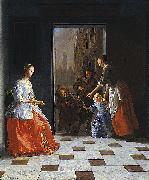 |
Jacob Ochtervelt
|
|
(1634, Rotterdam - 1682, Amsterdam), was a Dutch Golden Age painter.
According to the RKD he was active in Haarlem where he was a student of Nicolaes Pietersz Berchem and later he moved back to Rotterdam (1655-1672) where he was a pupil of Ludolf de Jongh. After the rampjaar he moved to Amsterdam |
|
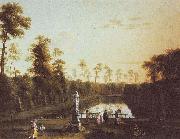 |
Jacob Philipp Hackert
|
|
(September 15, 1737 - April 28, 1807) was a landscape painter from Brandenburg, who did most of his work in Italy.
Hackert was born in 1737 in Prenzlau in the Margraviate of Brandenburg (now in Germany). He trained with his father Philipp (a portraitist and painter of animals) and his uncle, before going to the Akademie der Kenste in Berlin in 1758. Later he traveled to Swedish Pomerania and Stockholm, where he painted murals.
He spent from 1765 to 1768 in Paris, with the Swiss Artist, Balthasar Anton Dunker, where he focused on painting in gouache. He met and was inspired by Claude Joseph Vernet, who was already famous as a painter of landscapes and seascapes, and the German engraver Johann Georg Wille.
In 1768 Hackert left Paris with his brother Georg, and went to Italy, basing himself mainly in Rome and Naples, where he produced many works for Sir William Hamilton. He travelled all over Italy, gaining a reputation as a talented landscape painter.
In 1786 he went to work for Ferdinand I of the Two Sicilies in Naples. He advised on the creation of a painting restoration laboratory at the Museo di Capodimonte, and supervised the transfer of the Farnese collections from Rome to Naples. By this time he had an international reputation, and won commissions from empress Catherine II of Russia, king Louis XVI of France and others. When Goethe visited Naples in 1786, he and Hackert became friends. |
|
|
|
|
|
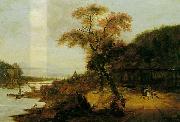 |
Jacob van der Does
|
|
(4 March 1623, Amsterdam - buried 17 November 1673, Sloten) was a Dutch Golden Age landscape painter.
Van der Does was the son of the secretary of the Amsterdam city council. He was more attracted to the arts than to note-taking, and went to study drawing with Claes Corneliszoon Moeyaert. He left at 21 to go to France, and from there on foot to Italy. In Rome he joined the Bentvueghels and was dubbed Tamboer, which means drummerboy, since he was somewhat short and had been meant for the military life. He studied with Pieter van Laer (Bamboots). When he eventually returned North, he settled in The Hague where he married Margaretha Boortens and got 4 sons and a daughter. His wife died in 1661. Houbraken liked his natural style of painting, and especially his way of painting sheep was very admirable.His wife's sister was Maria Boortens, and they both were good artists themselves. All three of them made drawings for the album of the wealthy Hague diplomat Cornelis de Glarges in 1659. Through Maria Boortens, Jacob van der Does was connected to Jacob van Campen and Adriaen van Nieulandt the younger. He became involved in the Guild of St. Luke in The Hague. He was one of the founders of the Confrerie Pictura in 1656. His pupils were Theodor Bernoille, Marcus de Bye, Gamaliel Day, Alexander Havelaer, Anthony Schinckels, and his sons Jacob II and Simon van der Does. |
|
|
|
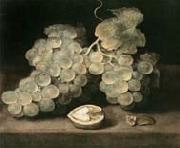 |
Jacob van Es
|
|
Flemish Baroque Era Painter, 1596-1666
was a Flemish Baroque still life painter active in Antwerp. His restrained ontbijt (breakfast) pieces share many similarities to contemporaries Osias Beert and Clara Peeters, and typically show various foods on a sharply angled table in the foreground. |
|
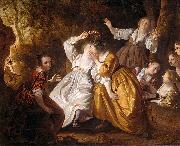 |
Jacob van Loo
|
|
(1614 - 26 November 1670) was a Flemish painter who is considered one of the Dutch Masters of the 17th Century. Van Loo is known for his conversational groupings, his use of a subtle color palette and his nudes. He was the founder of the Van Loo family of painters.
Van Loo was born in Sluis, Zeeland, in the Dutch Republic. Some sources have spe,culated that his father, Jan van Loo, may have been a notary, but more often his father is described as a painter from whom Jacob van Loo received his early training. Little is known of Van Loo's early history due to the destruction of the city archives in Sluis during World War II.
His early influences included Thomas de Keyser and Jacob Adriaensz Backer. In 1642, van Loo moved to Amsterdam, where his contemporaries included Rembrandt, Frans Hals, and Bartholomeus van der Helst. In 1643 he married the sister of the painter, Martinus Lengele. The couple had six children. They lived on Rozengracht in the Jordaan district of Amsterdam. Eglon van der Neer became one of his pupils. In 1660, Van Loo fled the city after fatally stabbing someone during an altercation at an inn. He was sentenced to death in absentia which forever prevented his return to Holland. Van Loo settled in Paris, where he was admitted to the Academie de peinture et de sculpture. He died in Paris in 1670.
Van Loo's work was done in the Baroque style that had originated in Rome. The Baroque style was popular throughout Europe during this period. Van Loo was a major influence on Johannes Vermeer as can be seen in Vermeer's painting, Diana and Her Companions.
Van Loo painted many portraits. Among his subjects were Johan Huydecoper van Maarssenveen; his sister, Leonara Huydecoper, who was married to Jan J. Hinlopen; Joan Ortt, who was later involved with Antoinette Bourignon; and his wife.
Jacob van Loo's son, Louis Abraham van Loo, was also a painter, as were his grandsons, Jean-Baptiste van Loo and Charles-Andra van Loo.
|
|
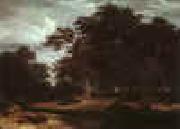 |
Jacob van Ruisdael
|
|
Dutch Baroque Era Painter, ca.1628-1682
Ruysdael's favorite subjects are simple woodland scenes, similar to those of Everdingen and Hobbema. He is especially noted as a painter of trees, and his rendering of foliage, particularly of oak leaf age, is characterized by the greatest spirit and precision. His views of distant cities, such as that of Haarlem in the possession of the marquess of Bute, and that of Katwijk in the Glasgow Corporation Galleries, clearly indicate the influence of Rembrandt.
He frequently painted coast-scenes and sea-pieces, but it is in his rendering of lonely forest glades that we find him at his best. The subjects of certain of his mountain scenes seem to be taken from Norway, and have led to the supposition that he had traveled in that country. We have, however, no record of such a journey, and the works in question are probably merely adaptations from the landscapes of Van Everdingen, whose manner he copied at one period. Only a single architectural subject from his brush is known--an admirable interior of the New Church, Amsterdam. The prevailing hue of his landscapes is a full rich green, which, however, has darkened with time, while a clear grey tone is characteristic of his seapieces. The art of Ruysdael, while it shows little of the scientific knowledge of later landscapists, is sensitive and poetic in sentiment, and direct and skillful in technique. Figures are sparingly introduced into his compositions, and such as occur are believed to be from the pencils of Adriaen van de Velde, Philip Wouwerman, and Jan Lingelbach.
Unlike the other great Dutch landscape painters, Ruysdael did not aim at a pictorial record of particular scenes, but he carefully thought out and arranged his compositions, introducing into them an infinite variety of subtle contrasts in the formation of the clouds, the plants and tree forms, and the play of light. He particularly excelled in the painting of cloudscapes which are spanned dome-like over the landscape, and determine the light and shade of the objects.
Goethe lauded him as a poet among painters, and his work shows some of the sensibilities the Romantics would later celebrate. |
|
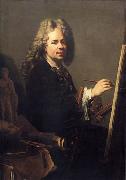 |
Jacob van Schuppen
|
|
Born in Fontainebleau, France, as the son of the painter-engraver Pieter van Schuppen, he worked in the Netherlands before moving to Vienna. He was taught to paint by his father and his uncle Nicolas de Largilliere.
In 1719 he was registered in Luneville, but he moved in the same year to Vienna where he became court painter. In 1725 he was appointed director of the Academy of Fine Arts Vienna, when it was refounded by Emperor Charles VI as the k.k. Hofakademie der Maler, Bildhauer und Baukunst (Imperial and Royal Court Academy of painters, sculptors and architecture). |
|
|
|
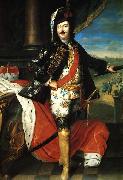 |
Jacob Wessel
|
|
painted Portrait of Hieronim Florian Radziwiłł. in 1746 |
|
|
|
|
|
|
|
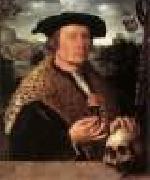 |
JACOBSZ, Dirck
|
|
Flemish Northern Renaissance Painter, ca.1497-1567
North Netherlandish painter, son of JACOB CORNELISZ. VAN OOSTSANEN. His birthdate is estimated from van Mander's claim that he died at the age of almost 70. His birthplace is unknown, but by about the age of three he was living in Amsterdam, where his father purchased a house in 1500. Dirck himself is documented in the city from 1546 until his burial. About 1550 he married Marritgen Gerritsdr., by whom he had two children, Maria Dircksdr. and Jacob Dircksz. War, also a painter. Dirck was trained by his father, probably around 1512, when Jan van Scorel was an apprentice. The two young artists may have remained friends, for in later years elements of Jan's mature, more Mannerist style can be seen in Dirck's paintings. Not only were Dirck's father and his brother, the little-known painter Cornelis Jacobsz. (d 1526-33), artists, his uncle Cornelis Buys I ( fl c. 1490-1524) |
|
|
|
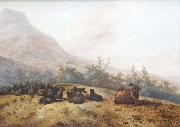 |
Jacobus Mancadan
|
|
(c. 1602, Minnertsga - 4 October 1680, Tjerkgaast) was a Dutch Golden Age painter mostly known for his pastoral landscapes.
|
|
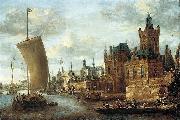 |
Jacobus Storck
|
|
(1641 - c.1700) was a Dutch Golden Age marine painter.
Storck was born and died in Amsterdam. According to Houbraken he was the brother of the marine painter Abraham Storck who painted views of the Rhine and inland ships, but who was not as gifted.
According to the RKD he was the second son of the marine painter Johannes Sturckenburgh, younger brother of the marine painter Johannes Storck and older brother of Abraham. Signed works by him are dated 1664-1687. He sometimes signed JA Storck, which since 1963 has been interpreted as a work by both Jacobus and Abraham together.
|
|
|
|
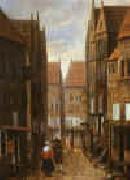 |
Jacobus Vrel
|
|
Dutch Baroque Era Painter, active ca.1654-1662
Dutch painter. Some 38 paintings, depicting domestic interiors, street scenes and a church interior, have been attributed to this enigmatic artist. Four copies after his works are possibly autograph; one drawing has also been ascribed to him. Over half of Vrel's paintings are signed or bear traces of signatures that were altered to read Johannes Vermeer or Pieter de Hooch, with whose paintings Vrel's work was often confused. Indeed, Theophile Thore discussed Vermeer as a townscape painter largely on the basis of works that were actually by Vrel. |
|
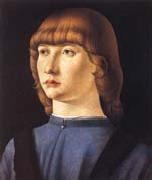 |
Jacometto
|
|
Italian Early Renaissance Painter, active 1472-1497 |
|
|
|
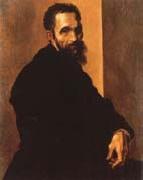 |
Jacopino del Conte
|
|
Italian Painter, ca.1510-1598
was an eminent Italian Mannerist painter, active in both Rome and Florence. A native of Florence, Jacopino del Conte was born the same year as another Florentine master Cecchino del Salviati (whom Conte outlived by 35 years) and, like Salviati and a number of other painters, he initially apprenticed with the influential painter and draftsman Andrea del Sarto. Conte's first frescoes, including Annunciation to Zachariah (1536), Preaching of Saint John the Baptist (1538), and Baptism of Christ (1541) were in the Florentine-supported Oratory of San Giovanni Decollato, located in Rome. The Preaching fresco was based on a drawing by Perin del Vaga. In 1547?C48, in collaboration with Siciolante da Sermoneta, Conte completed the fresco decoration of the chapel of San Remigio in San Luigi dei Francesi. In 1552, he painted another work for the San Giovanni Decollato Oratory, the altarpiece Deposition, whose designs are sometimes attributed to Daniele da Volterra. |
|
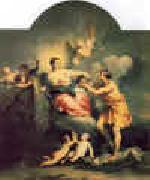 |
Jacopo Amigoni
|
|
1685-1752
Italian Jacopo Amigoni Galleries
He was born in Naples or Venice. Amigoni initially painted both mythological and religious scenes; but as the panoply of his patrons expanded northward, he began producing many parlour works depicting gods in sensuous languor or games. His style influenced Giuseppe Nogari. Among his pupils were Charles Joseph Flipart, Michelangelo Morlaiter, Pietro Antonio Novelli, Joseph Wagner, and Antonio Zucchi.
Starting in 1717, he is documented as working in Bavaria in the Castle of Nymphenburg (1719); in the castle of Schleissheim (1725-1729); and in the Benedictine abbey of Ottobeuren. He returned to Venice in 1726. His Arraignment of Paris hangs in the Villa Pisani at Stra. From 1730 to 1739 he worked in England, in Pown House, Moor Park and in the Theatre of Covent Garden. From there, he helped convince Canaletto to travel to England by telling him of the ample patronage available.
From his travel to Paris in 1736, he met the celebrated castrato named Farinelli. Later in Madrid, he was to paint a self-portrait with the singer and entourage. He also encountered the painting of François Lemoine and Boucher.
In 1739 he returned to Italy, perhaps to Naples and surely to Montecassino, in whose Abbey existed two canvases (destroyed during World War II). Until 1747, he travelled to Venice to paint for Sigismund Streit, for the Casa Savoia and other buildings of the city. In 1747 he left Italy and established himself in Madrid. There he became court painter to Ferdinand VI of Spain and director of the Royal Academy of Saint Fernando. He died in Madrid. |
|
 |
Jacopo Bassano
|
|
Italian
c1510-1592
Jacopo Bassano Gallery
He was apprenticed to his father, with whom he collaborated on the Nativity (1528; Valstagna, Vicenza, parish church). In the first half of the 1530s Jacopo trained in Venice with Bonifazio de Pitati, whose influence, with echoes of Titian, is evident in the Flight into Egypt (1534; Bassano del Grappa, Mus. Civ.). He continued to work in the family shop until his fathers death in 1539. His paintings from those years were mainly altarpieces for local churches; many show signs of collaboration. He also worked on public commissions, such as the three canvases on biblical subjects (1535-6; Bassano del Grappa, Mus. Civ.) for the Palazzo Communale, Bassano del Grappa, in which the narrative schemes learnt from Bonifazio are combined with a new naturalism. From 1535 he concentrated on fresco painting, executing, for example, the interior and exterior decoration (1536-7) of S Lucia di Tezze, Vicenza, which demonstrates the maturity of his technique. |
|
|
|
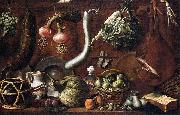 |
Jacopo Chimenti
|
|
(30 April 1551 - 30 September 1640) was an Italian late-mannerist painter.
Born in Florence as Jacopo Chimenti (Empoli being the birth place of his father), he worked mostly in his native city. He apprenticed under Maso da San Friano. Like his contemporary in Counter-Maniera (Counter-Mannerism), Santi di Tito, he moved into a style often more crisp, less contorted, and less crowded than mannerist predecessors like Vasari. He collaborated with Alessandro Tiarini in some projects. Among his pupils were Felice Ficherelli, Giovanni Battista Brazze (Il Bigio), Giovanni Battista Vanni, and Virgilio Zaballi.
In later years, the naturalism becomes less evident. The porcelain features of his figures accentuated the academic classical trends that restrained Florentine painting during the Baroque period. |
|
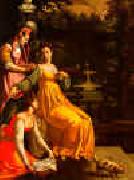 |
Jacopo da Empoli
|
|
1554-1640
Italian
Jacopo da Empoli Location
Italian painter and draughtsman. He lived and worked in Florence all his life, and he followed Santi di Tito in the return to the clarity of the Florentine High Renaissance. He absorbed the ideas of his more innovative contemporaries and became one of the most popular painters of altarpieces for churches in Florence and Tuscany. He was also a distinguished still-life painter and received many commissions from private patrons, among them the Medici. Empoli painting is distinguished by simple, lucid forms, strong colour and direct and clear interpretation of the subject. |
|
|
|
|
|
|
|
|
|
|
|
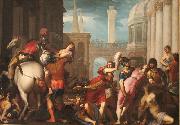 |
Jacopo Ligozzi
|
|
(1547 - 1627) was an Italian painter, illustrator, designer, and miniaturist of the late Renaissance and early Mannerist styles.
Born in Verona, he was the son of the artist Giovanni Ermano Ligozzi, and part of a large family of painters and artisans. After a time in the Habsburg court in Vienna where he displayed drawings of animal and botanical specimens, he was invited to come to Florence, receiving the patronage of the Medici as one of the court artists. Upon the death of Giorgio Vasari in 1574, he became head of the Accademia e Compagnia delle Arti del Disegno, the officially patronized guild of artists, which was often called to advise on diverse projects. He served Francesco I, Ferdinando I, Cosimo II and Ferdinando II, Grand Dukes of Tuscany. He worked on some projects with Bernardino Poccetti. Late in life, he was named director of the grand-ducal Galleria dei Lavori, a workshop providing designs for artworks made mainly for export: embroidered textiles and for the newly popular medium of pietre dure, mosaics of semiprecious stones and colored marbles.
Jacopo Ligozzi was born at Verona c. 1543, He died after 1632. He painted some frescoes for the cloister of the Ognissanti. He painted for Santa Maria Novella a canvas of St. Raymond resuscitating a Child and a Martyrdom of St. Dorothea for the church of the Conventuali at Pescia. Both Agostino Carracci and Andrea Andreani engraved some of his works
|
|
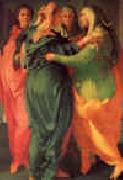 |
Jacopo Pontormo
|
|
Italian 1494-1557 Jacopo Pontormo Galleries
Italian painter and draughtsman. He was the leading painter in mid-16th-century Florence and one of the most original and extraordinary of Mannerist artists. His eccentric personality, solitary and slow working habits and capricious attitude towards his patrons are described by Vasari; his own diary, which covers the years 1554-6, further reveals a character with neurotic and secretive aspects. Pontormo enjoyed the protection of the Medici family throughout his career but, unlike Agnolo Bronzino and Giorgio Vasari, did not become court painter. His subjective portrait style did not lend itself to the state portrait. He produced few mythological works and after 1540 devoted himself almost exclusively to religious subjects. His drawings, mainly figure studies in red and black chalk, are among the highest expressions of the great Florentine tradition of draughtsmanship; close to 400 survive, forming arguably the most important body of drawings by a Mannerist painter. His highly personal style was much influenced by Michelangelo, though he also drew on northern art, primarily the prints of Albrecht Derer. |
|
 |
Jacopo Robusti Tintoretto
|
|
1518-1594
Italian Tintoretto Galleries
The real name of Tintoretto was Jacopo Robusti, but he is better known by his nickname, meaning the "little dyer, " his father having been a silk dyer. The artist was born in Venice and lived there all his life. Even though his painting is distinguished by great daring, he seems to have led a rather retired life, concerned only with his work and the well-being of his family. His daughter Marietta and his sons Domenico and Marco also became painters, and Domenico eventually took over the direction of Tintoretto's large workshop, turning out reliable but un-inspired pictures in the manner of his father. Some of them are, on occasion, mistaken for works of the elder Tintoretto.
Tintoretto appears to have studied with Bonifazio Veronese or Paris Bordone, but his true master, as of all the great Venetian painters in his succession, was Titian. Tintoretto's work by no means merely reflects the manner of Titian. Instead he builds on Titian's art and brings into play an imagination so fiery and quick that he creates an effect of restlessness which is quite opposed to the staid and majestic certainty of Titian's statements. If Tintoretto's pictures at first sight often astonish by their melodrama, they almost inevitably reveal, at closer observation, a focal point celebrating the wonders of silence and peace. The sensation of this ultimate gentleness, after the first riotous impact, is particularly touching and in essence not different from what we find (although brought about by very different means) in the pictures of Titian and Paolo Veronese.
Tintoretto was primarily a figure painter and delighted in showing his figures in daring foreshortening and expansive poses. His master in this aspect of his art was Michelangelo. Tintoretto is supposed to have inscribed on the wall of his studio the motto: "The drawing of Michelangelo and the color of Titian." Unlike Michelangelo, however, Tintoretto worked and drew very quickly, using only lights and shadows in the modeling of his forms, so that his figures look as if they had gained their plasticity by a kind of magic. In the rendering of large compositions he is reported to have used as models small figures which he made of wax and placed or hung in boxes so cleverly illuminated that the conditions of light and shade in the picture he was painting would be the same as those in the room in which it was to be hung. |
|
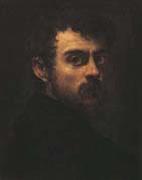 |
Jacopo Tintoretto
|
|
1518-1594
Italian painter. His father was a silk dyer (tintore); hence the nickname Tintoretto ("Little Dyer"). His early influences include Michelangelo and Titian. In Christ and the Adulteress (c. 1545) figures are set in vast spaces in fanciful perspectives, in distinctly Mannerist style. In 1548 he became the centre of attention of artists and literary men in Venice with his St. Mark Freeing the Slave, so rich in structural elements of post-Michelangelo Roman art that it is surprising to learn that he had never visited Rome. By 1555 he was a famous and sought-after painter, with a style marked by quickness of execution, great vivacity of colour, a predilection for variegated perspective, and a dynamic conception of space. In his most important undertaking, the decoration of Venice's Scuola Grande di San Rocco (1564 ?C 88), he exhibited his passionate style and profound religious faith. His technique and vision were wholly personal and constantly evolving. |
|
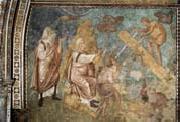 |
Jacopo Torriti
|
|
Italian painter, Roman school active c. 1270-1300, Italian painter and mosaicist. Two mosaics in Rome are signed by him: one, on the apse of S Giovanni in Laterano, that once bore the date 1291 (or, according to some sources, 1290 or 1292); and another on the apse and triumphal arch of S Maria Maggiore, now replaced by a 19th-century restoration but at one time dated 1295 or 1296. Torriti is also known to have executed a mosaic for Arnolfo di Cambio's tomb of Pope Boniface VIII (1296; destr.; see ARNOLFO DI CAMBIO) in Old St Peter's, Rome. Torriti was active during the same period as Cimabue and Giotto, Pietro Cavallini and Arnolfo di Cambio, but his fame has been obscured by theirs, no doubt because of his closer links with Byzantine art. He was nevertheless one of the most important artists working in Rome during the papacy of Nicholas IV (1288-92) and was entrusted with some of the most prestigious commissions of the day. |
|
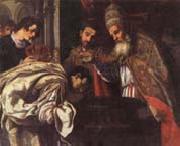 |
Jacopo Vignali
|
|
Italian painter who died on 03 August 1664
Italian painter. At an early age he entered the studio of Matteo Rosselli in Florence, and his first works, Virgin and Saints (1616; Florence, S Brigida, Santuario della Madonna del Sasso) and the ceiling painting Love of the Fatherland (1616; Florence, Casa Buonarroti), were influenced by Rosselli and Ludovico Cigoli. In 1616 he enrolled at the Accademia del Disegno in Florence, becoming an academician in 1622. In the 1620s he moved away from Rosselli's influence and developed a style distinguished by dramatic light effects, rich colour and painterly technique and by the expression of deep emotion. The decade opened with the Investiture of St Benedict (1620; Florence, Semin. Maggiore), one of a series of works painted in honour of St Benedict for the Confraternit? di S Benedetto Bianco, to which Vignali had belonged since 1614. Having learnt the technique of fresco painting from Rosselli, he also began to work in that medium and was involved in the decoration of the Casa Buonarroti throughout the decade, the ceiling fresco Jacob's Dream dating from 1621. |
|
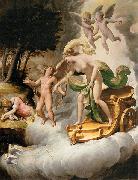 |
Jacopo Zanguidi Bertoia
|
|
Jacopo Bertoia, also known as Giacomo Zanguidi or Jacopo Zanguidi or Bertoja, (1544 - ca. 1574), was an Italian painter of a late-Renaissance or Mannerist style that emerged in Parma towards the end of the 16th century.
He was strongly influenced by Parmigianino.
Born in Parma, he apparently studied in Bologna with Sabatini. His masterpiece is the Sala del Bacio, in the Palazzo del Giardino in Parma. He also helped decorate the Sala di Orfeo in the same palace. He was part of the team that decorated the walls of the Oratorio del Gonfalone (Entry into Jerusalem) in Rome. He was commissioned by Cardinal Alessandro Farnese in 1572-1573 to paint galleries (Sale del Giudizio, della Penitenza, dei Sogni, as well as the Anticamera degli Angeli) of the Villa Farnese in Caprarola, where he replaced the role of Taddeo Zuccari. |
|
|

